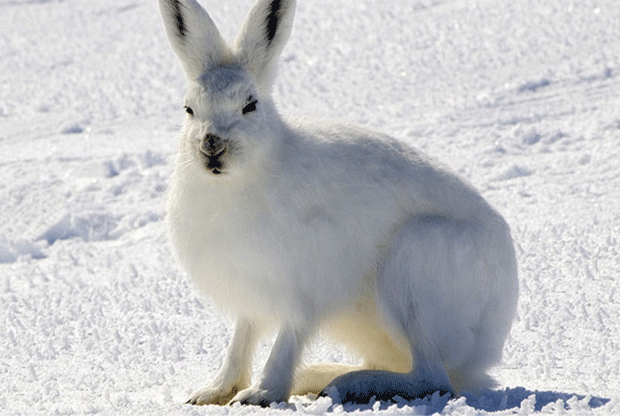|
Animals that live in the Arctic (either full time or
seasonally) are adapted to extreme conditions. Many animals who
overwinter in the Arctic (like the Arctic fox and the ermine) have a
coat that thickens and changes color to white during the winter as
camouflage in the snow (blending into the background is called cryptic
coloration).
|
|
Muskox
The massive muskox has been inhabiting the planet's arctic tundras for
thousands of years, digging through the snow to feed off frozen grasses
in winter and filling up on flowers, grasses and other arctic plants
during the summers. You'll often see them in herds of 20 to 30 animals,
all led by a single female. |
|
 |
|
Arctic Hare
The speedy and well-camouflaged Arctic hare can be found in the harsh
tundra of Alaska, Canada and Greenland. Their coats only turn white in
the winter to help them hide from predators (like the lynx) in the snow,
but in summers, they take on a dusty brown coloring. |
|

|
|
Wolverine
The wolverine found in the arctic is a far cry from the superhero in the
movies. While this little guy does have semi-retractable claws, they're
mostly for digging. Wolverines are the largest member of the weasel
family and generally feed on rabbits, rodents and sometimes weakened
caribou in their habitats in the tundra and boreal forests of North
America, Europe and Asia. |
|

|
|
Canada Lynx
The Arctic has its own cast of characters, many of them highly unusual.
The Canada lynx, a relative of the bobcat, is also one of the most
elusive. If you're lucky enough to spot one, you'll recognize it by the
black tufts of hair in its ears and its over-sized furry feet, helpful
when stalking across the surface of the snow. These majestic cats feed
mainly on the equally hard-to-find Arctic hare. |
|
 |
|
Arctic Fox
Thanks to a bushy, snowy white coat, the arctic fox can survive in
temperatures as low as -58 degrees Fahrenheit -- handy when you live
almost exclusively in the Arctic Circle. These canines are found in
nearly every Arctic ecosystem in the Northern Hemisphere, but they have
the honor of being Iceland's only native land mammal.
|
|
 |
|
Snowy Owl
When most bird species head south for the winter, the snowy owl stays
put and is the only Arctic bird species to do so. You can tell the age
of a snowy owl by its coloration; adult male owls have pure white
feathers while younger owls exhibit dark grey, spotted feathers. Adult
females are white with grey spotting on their wings. Did you know Harry
Potter's pet Hedwig was a snowy owl?
|
|
 |
|
Narwhal
The narwhal, or "unicorn of the sea," has got to be one of the world's
most bizarre animals. This whale species indigious to the Arctic coastal
and river waters is famous for the horn-like tusk that grows through the
upper lip of male narwhals to a length of up to 9 feet. Scientists still
aren't sure what the tusk is for.
|
|
 |
|
Beluga Whale
You may have seen a beluga whale at SeaWorld, but have you ever seen one
in the wild? If you want to cross that off your bucket list, you'll have
to head north to the waters off the coast of Alaska, Canada, Greenland
or Russia, where the social whales spend much of their time in the
Arctic or sub-Arctic waters. |
|
 |